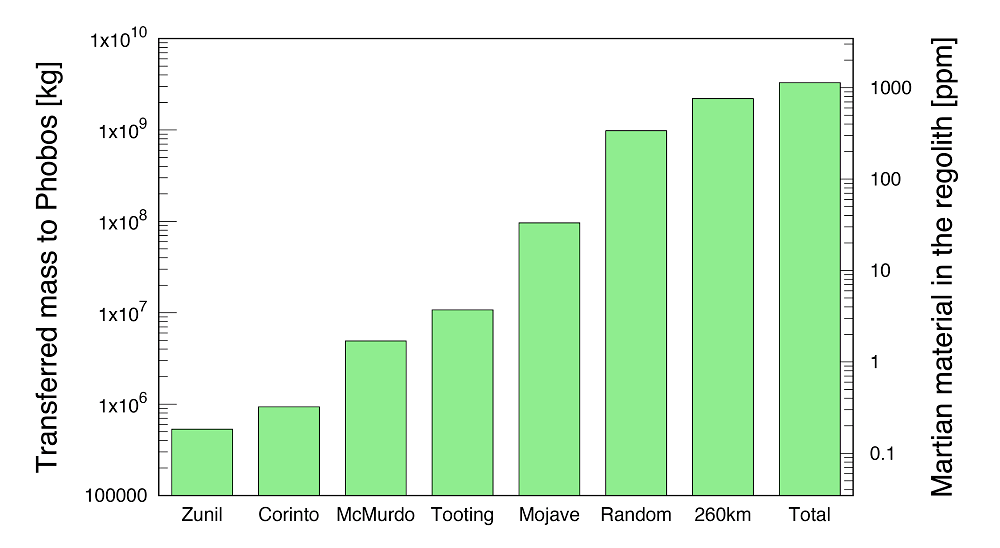Transport of impact ejecta from Mars to its moons as a means to reveal Martian history
Feb. 9, 2021 | GATEWAY to Academic Articles
Meteorite bombardments on Mars throughout its history eject its surface materials into space, a part of which can be delivered to Martian moon Phobos. Using state-of-the-art numerical approaches, the research team reports that the amount of delivered Martian materials is 10-100 times more than previously estimated. Before NASA and ESA complete the sample return mission from Mars in the early 2030s, JAXA can potentially get the Martian sample from its moon, Phobos, in the late 2020s.
Research Summary
Mars has two small moons Phobos and Demos. Phobos has been selected as a target body of the JAXA-led Martian Moons eXploration (MMX) mission, whose launch is scheduled in 2024. MMX is a sample return mission to Earth that plans to bring surface materials of Phobos back to Earth in 2029.
After the formation of Mars, Mars has continuously experienced asteroidal impacts. These impacts have produced impact ejecta originated from the Mars surface, and a fraction of the impact-ejecta is delivered to Phobos and Deimos. Phobos is closer to Mars and larger in size than Deimos. Thus, more ejecta is transferred from Mars to Phobos than to Deimos (Fig.1).

High-resolution simulations of a variety of impacts of small bodies to Mars were performed and the resultant impact ejecta distributions were obtained for different impact conditions. Then, a detailed trajectory analysis of the impact ejecta was performed to statistically evaluate the mass and conditions of the impact ejecta to reach Phobos.
These state-of-the-art numerical approaches showed that materials delivered from Mars to Phobos were much less shocked/altered than Martian meteorites and were homogeneously mixed in the regolith of Phobos. The total amount of the delivery of Mars materials to Phobos surface is updated about 10 to 100 times larger than the previous estimation that used a simple calculation (Fig.2). Numerical simulations showed that Mars ejecta on Phobos surface (i.e., potential sample materials of MMX mission) covers all its geological eras and consists of all types of rocks, from sedimentary to igneous, which would provide us a wealth of “time-resolved” geochemical information about the evolution of Martian surface environments.

In the 2020s-2030s, the NASA-ESA-led Mars sample-return (MSR) missions are also planned for a specific crater Jezero Crater on Mars. MMX and MSR missions will both potentially bring Mars samples back to Earth. These independent missions will play essential and complementary roles in revealing the enigmatic history of Mars.
As a result of an efficient radiation-induced sterilization on the surface of Phobos, our results satisfy the criterion defined by the planetary protection*2 policy of the Committee on Space Research (COSPAR) because the most likely probability of microbial contamination for return samples is estimated to be much lower than the critical value.
Terminologies
- *1 1ppm indicates parts per million.
- *2 Planetary Protection requires protecting planetary bodies from contamination by Earth life as well as protecting Earth from potential extraterrestrial life forms that may be returned from other planetary bodies.
Information
| Journal Title | Scientific Reports |
|---|---|
| Full title of the paper | Transport of impact ejecta from Mars to its moons as a means to reveal Martian history |
| DOI | https://doi.org/10.1038/s41598-019-56139-x |
| Publish date | 2019/12/27 (JST) |
| Author(s) |
Ryuki Hyodo (ISAS/JAXA) Kosuke Kurosawa (Chiba Institute of Technology), Hidenori Genda (Tokyo Institute of Technology/ELSI), Tomohiro Usui (ISAS/JAXA), Kazuhisa Fujita (ISAS/JAXA) |
| ISAS or JAXA member(s) among author(s) | HYODO Ryuki (Dept. of Solar System Sciences), Tomohiro Usui (Dept. of Solar System Sciences), Kazuhisa Fujita (Dept. of Space Flight Systems) |


 HYODO Ryuki / Dept. of Solar System Sciences, ISAS
HYODO Ryuki / Dept. of Solar System Sciences, ISAS